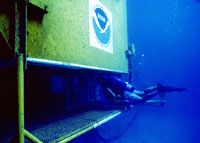Jim Leichter is a postdoctoral researcher at Woods Hole Oceanographic Institution. This is his fourth saturation diving mission at Aquarius, where a team of six aquanauts will spend nine days in the underwater laboratory 63 feet below the ocean’s surface in Florida Keys National Marine Sanctuary.
Wednesday, 14 Jun 2000
CONCH REEF, Fla
CONCH REEF, Fla. We certainly needed all our wetsuit layers on the early dive this morning. Out on the “dawn patrol” at 6:00 a.m., it was still nearly dark on the bottom. It seemed particularly dark as we headed downslope and quickly ran into a layer of considerably colder water that had moved up onto the reef. Of course, this cold water and the nutrients it carries are exactly what we are trying to sample, but that seemed to be of rather little consolation at 6:00 in the morning when the rest of the crew were happily up in their bunks. The cold-water layer had slid in and up the reef, but was confined to a relatively thin wedge — and in between taking samples every half hour we were able to float a few meters above the bottom and stay warmer. The difference in temperature between the warmer and colder water was probably about 4 degrees C, but that was certainly enough to make a big difference in how it felt.

Entering Aquarius through the wet porch.
Photo: NOAA and UNC Wilmington.
We are able to stay down at a depth of 100 feet for about 60 or 70 minutes at a time before swimming back to Aquarius to refill our tanks, but since our total allowable bottom time is about 3.5 hours on the first dive of the day at this depth, we were able to go back down a total of three times to collect a series of samples. Finally, around 9:30 a.m., we were back in Aquarius, drinking warm coffee while the second dive team took their turn collecting samples and deploying equipment.
In the afternoon we were out even longer, heading out around 2 p.m., but with the last one of the team not back inside until a little after 8 p.m. After returning from the scuba dive, I cruised outside on the hookah rig. This is essentially just a regulator second stage on a 150-foot hose from an air supply located at Aquarius, and it allows a single diver to be out on his or her own with an unlimited air supply — and no time limit as long as one stays at the same depth as the Habitat entry.
We also continued our measurements of currents around the corals on a very small scale using a moveable instrument that is connected to a computer located in Aquarius. To coordinate the position of the instrument outside in the water with the data output on the computer screen in the Habitat, we use full-face mask scuba regulators that have radios that allow the diver to talk with us inside Aquarius.
It’s late and everyone is ready for sleep. Tomorrow we head out at 6 a.m. again.

